Students can access the CBSE Sample Papers for Class 11 Accountancy with Solutions and marking scheme Term 2 Set 2 will help students in understanding the difficulty level of the exam.
CBSE Sample Papers for Class 11 Accountancy Term 2 Set 2 with Solutions
Time : 2 Hours
Maximum Marks: 40
General Instructions:
- The Question Paper consists of two Parts – A and B. There are total 12 questions. All questions are compulsory.
- Part – A consists of Accounting Process.
- Part – B consists of Financial Accounting and Computers in Accounts.
- Question Nos. 1 to 2 and 5 to 6 are short answer type questions – I carrying 2 Marks each.
- Question Nos. 3 and 7 to 9 are short answer type questions – II carrying 3 Marks each.
- Questions Nos. 4 and 10 to 12 are long answer type questions carrying 5 marks each.
- There is no overall choice. However, an internal choice has been provided in 3 questions of three marks and 1 question of five marks.
Part-A (12 marks)
Accounting Process
Question 1.
Calculate the due dates of the following bills: [2]
| Date of Bill | Period |
| (a) 29th January 2020 | 1 month |
| (b) 23rd December 2020 | 60 days |
| (c) 13th April 2020 | 3 months |
| (d) 10th January 2019 | 2 months |
Answer:
(a) 29th Jan + 1 months + 3 days = 3rd March 2020
(b) 23rd Dec + 60 days + 3 days = 21st February 2021
(c) 13th April + 3 months + 3 days = 16lhAugust 2020
(d) 10th Jan + 2 months + 3 days = 13th March 2019
![]()
Question 2.
The following is the Trial Balance of Thakur Bros, as at 28th February 2018:
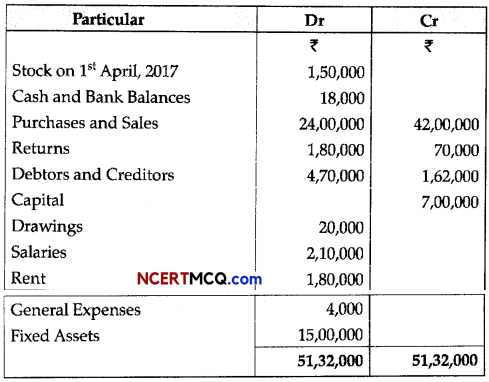
The following transactions were recorded during the month of March 2018 :
(a) Credit purchase of goods ₹ 2,20,000
(b) Credit sales of goods ₹ 3,75,000
(c) Purchase Return ₹ 15,000
(d) Sales Return ₹ 10,000
You are required to prepare the Trial Balance as on 31st March 2018. [2]
Answer:
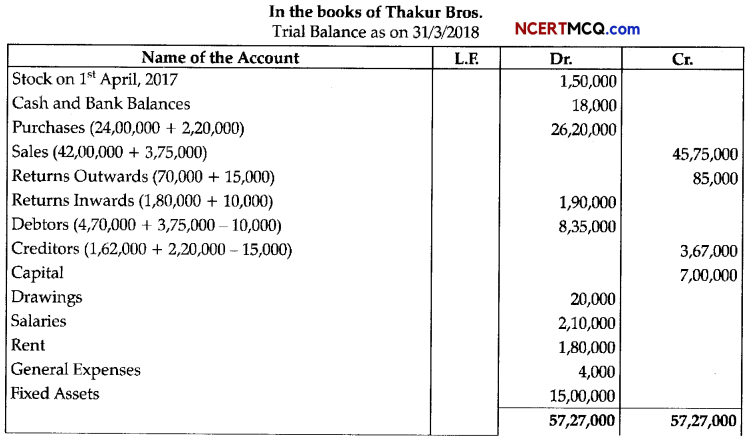
Commonly Made Errors: Students tend to subtract the Sales return and Purchase Return from the Sales and purchases respectively.
Answering Tip: Students need to keep in mind the journal entries of the returns and see the accounts affected by the transactions.
![]()
Percent yield calculator is online tool that finds the percent yield for the given amount of actual yield calculator and theoretical yield.
Question 3.
On 1st October, 2014, ₹ sells goods to Y for ₹ 25,000 and draws two bills of exchange on him: the first for ? 10,000 for two months and second for ₹ 15,000 for 3 months. Y accepts and returns these bills to ₹. Both the bills are sent to the bank for collection. In due course, ₹ receives the information from the bank that the bill for ₹ 10,000 has been duly met and the other bill for ₹ 15,000 has been dishonoured. Noting charges paid on the dishonour of the second bill are ₹100. Pass Journal entries in the books of ₹. [3]
OR
A purchased goods for ₹ 15,000 from B on 1st March. 2013 and gives him two Bills. One for ₹ 10,000 at two months and other for ₹ 5000 at four months. A meet the first bill at maturity but on 25th June, 2013 he was declared insolvent and 60 paise in a rupee amount was received from him on August 20,2013. Journalise in the books of B and prepare A’s A/c. [3]
Answer:
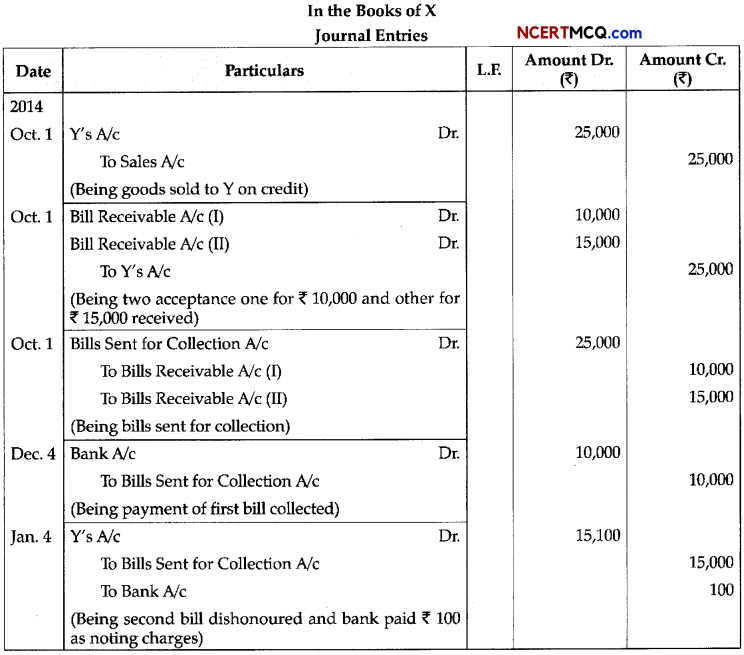
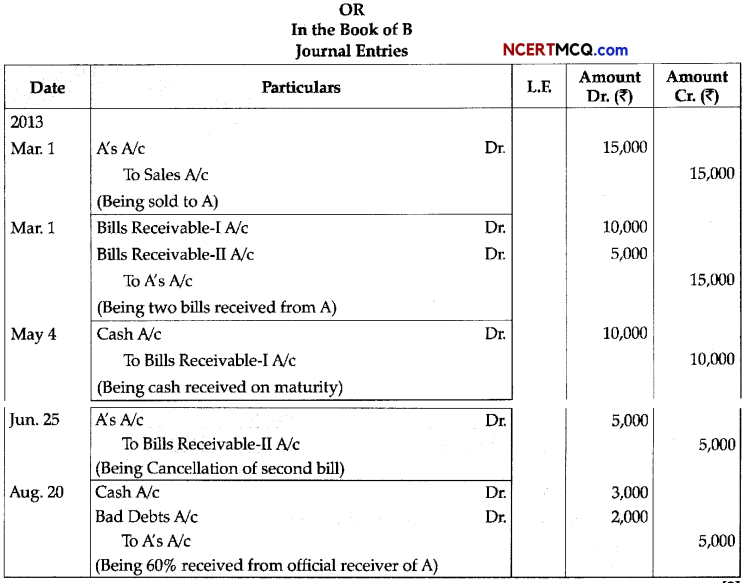

Commonly Made Errors: On the payment of second bill, some students debit the unreceived amount to discount A/c.
Answering Tip: Since A has been declared insolvent, the amount not received from him becomes unrecoverable. Therefore, this amount is to be debited to Bad debts A/c.
![]()
Question 4.
Rectify the following errors through Journal entries and also show the wrong entries passed:
(i) An amount of ₹ 4,500 spent for the extension of machinery has been debited to Wages Account.
(ii) ₹ 150 paid as cartage for the newly purchased furniture, posted to Cartage Account.
(iii) A builder’s bill for ₹ 3,000 for erection of a small cycle shed was debited to Repairs Account.
(iv) A cheque of ₹ 1,500 received from Komal was dishonoured and had been posted to the debit side of ‘Allowance A/c’.
(v) ₹ 750 paid for the newly purchased ‘Fan’ posted to Purchase Account. (RD [5]
Answer:
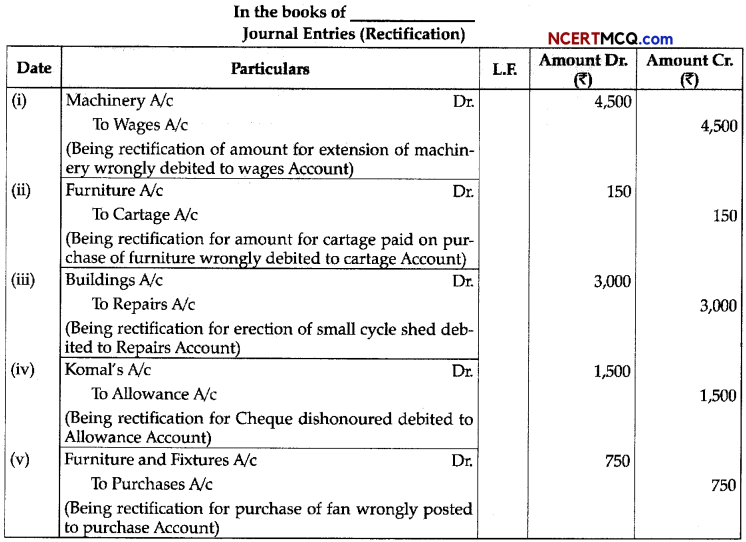

Commonly Made Errors:
- Students debit the Office expenseaccount instead of furniture and fixtures A/c in the rectification entry for purchase of fan.
- Students tend to debit Bank A/c for rectifying the entry of the dishonour of cheque.
Answering Tips
- As purchase of fan is a part of office fixtures, so it will be rectified by debiting the furniture and fixtures A/c.
- When Cheque received is dishonoured, the account of the person from whom the cheque was received is debited.
![]()
Part-B (28 marks)
(Financial Accounting and Computer In Accounts)
Question 5.
Operating profit earned by M/s Arora and Sachdeva in 2013-14 was ₹ 17,00,000. Its non-operating incomes were ₹ 1,50,000 and non-operating expenses were ₹ 3,75,000. Calculate the amount of net profit earned by the firm. [2]
Answer:
Net Profit = Operating Profit + Non- operating Income – Non-operating Expenses
= ₹ 17,00,000 + ₹ 1,50,000 – ₹ 3,75,000 = ₹ 14,75,000
Net profit earned by M/S Arora and Sachdeva in 2005-06 was ₹ 14,75,000.
Question 6.
From the following information, calculate capital at the beginning: [2]
| ₹ | |
| Capital at the end of the year | 4,00,000 |
| Drawings made during the year | 60,000 |
| Fresh Capital introduced during the year | 1,00,000 |
| Profit of the current year | 80,000 |
Answer:

Question 7.
Briefly discuss the functional components of a computer system. [3]
OR
Differentiate between Manual and Computerised Accounting System.
Answer:
A computer is a combination of hardware and software resources which integrate together and provide various functionalities to the user. Hardware is the physical component of a computer like the processor, memory devices, monitor, keyboard etc. while software is the set of programs or instructions that are required by the hardware resources to function properly. There are a few basic components that aids the working-cycle of a computer i.e. the Input- Process- Output Cycle and these are called as the functional components of a computer. It needs certain input, processes that input and produces the desired output. The input unit takes the input, the central processing unit does the processing of data and the output unit produces the output. The memory unit holds the data and instructions during the processing.
OR

![]()
Question 8.
Hari maintains his books of account on single entry system. His books provide the following information:
| Particulars | Jan. 1,2012 (₹) | Dec. 31,2012 (₹) |
| Furniture | 200 | 200 |
| Stock | 2,800 | 3,050 |
| Sundry Debtors | 2,100 | 3,400 |
| Cash | 150 | 200 |
| Sundry Creditors | 1,750 | 1,900 |
| Bills Receivable | — | 300 |
| Loan | — | 500 |
| Investments | — | 1,000 |
His drawings during the year were ₹ 500.
Depredate furniture by 10% and provide a reserve forbad debts at 10% on sundry debtors. Calculate profit or loss earned by the firm. [3]
OR
Ronak, who keeps his books on Single Entry System, has his capital on 31st March, 2016, ₹ 1,20,000 and on 1st April, 2015 was ₹ 1,16,700. He further informs that during the year, he withdrew for his personal expenses ₹ 19,400. He also sold his personal investment of ₹ 1,10,000 at 5% premium and brought that money into the business. Prepare a statement of Profit or Loss. [3]
Answer:
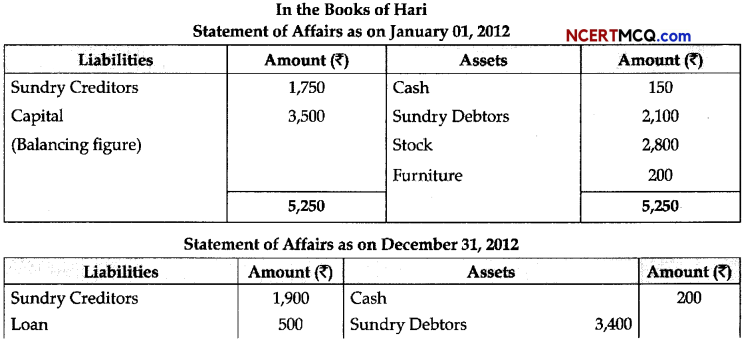
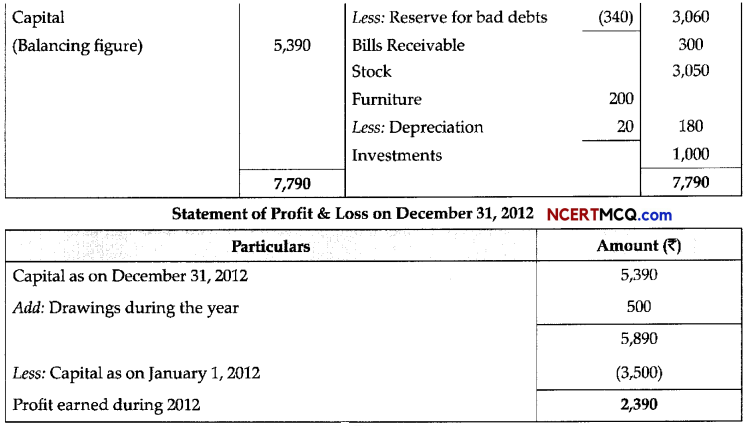
OR
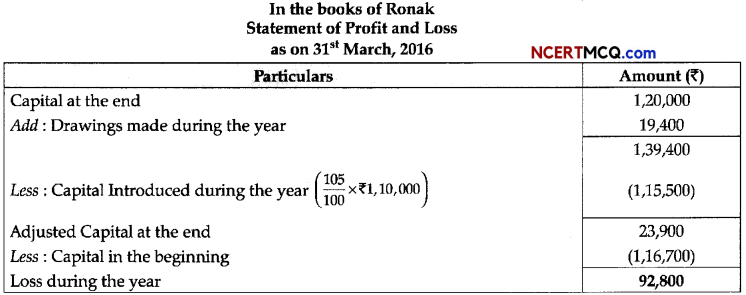
![]()
Question 9.
Give Journal Entries for the following Adjustments in final accounts assuming CGST and SGST @9% each:
(A) Salaries ₹ 5,000 are outstanding.
(B) Insurance amounting to ₹ 2,000 is paid in advance
(C) ₹ 4,000 for rent have been received in advance.
(D) Commission earned but not yet received ₹ 1,000. [3]
Answer:

Commonly Made Errors: Students calculate GST for Salaries and Prepaid Insurance and Rent.
Answering Tip: Students need to recall that GST is not levied on Salaries and GST is not accounted on Prepaid expenses.
Question 10.
The following is the statement of affairs of Avinash as on 1st April 2014:
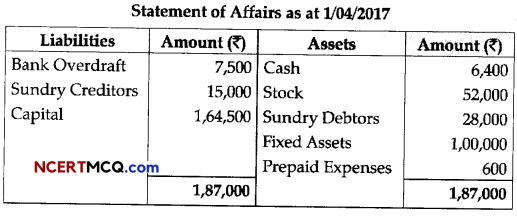
His position on 31st March 2015 are:
Cash in Hand ₹ 3,000; Cash at Bank ₹ 5,000; Stock ₹ 44,000; Debtors ₹ 21,000; Fixed Assets ₹ 80,000; Creditors ₹ 22,000.
You are informed that Avinash has taken stocks worth ₹ 4,500 for his private use and that he has been regularly transferring ₹ 2,000 per month from his business banking account by way of drawings. Out of his drawings, he spent ₹ 15,000 for purchasing a scooter for the business on 1st October 2017.
You are requested to find out his profit or loss and also prepare the Statement of Affairs after considering the following:
(a) Depreciate Fixed Assets and Scooter by 10% p.a.
(b) Write Bad-debts ₹ 1,000 and provide 5% for doubtful debts on Sundry Debtors.
(c) Commission earned but not received by him was ₹ 2,500.
Answer:
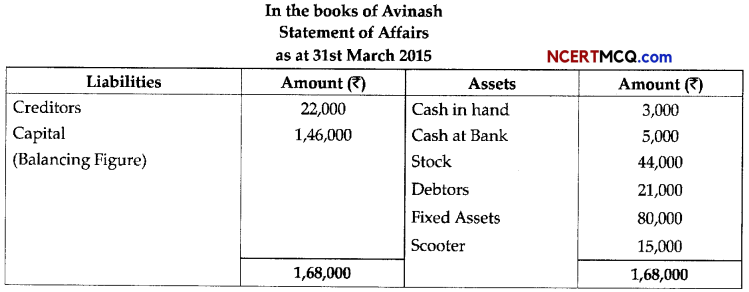
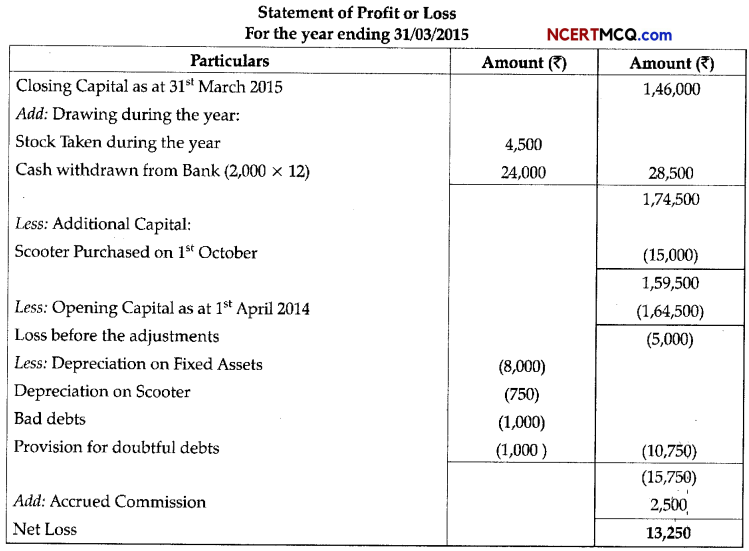
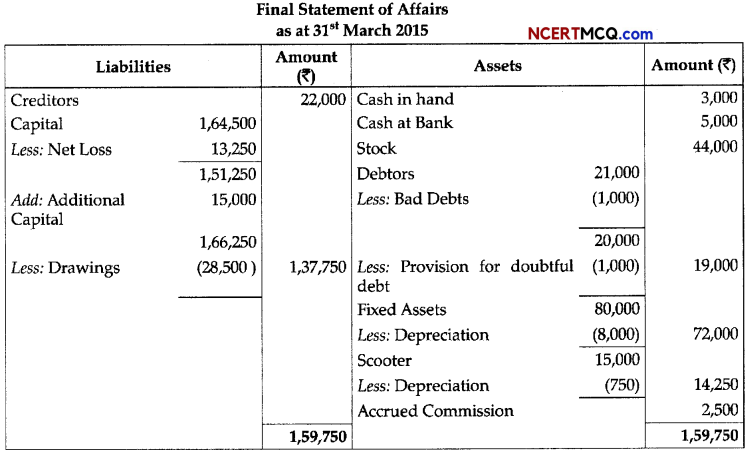
Working capital:

![]()
Question 11.
The following balance was extracted from the books of M/s Panchsheel Garments on March 31st, 2014.
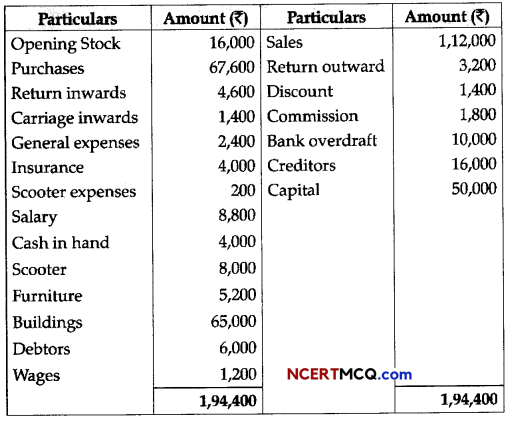
Prepare the trading and profit and loss account for the year ended March 31st, 2014 and a balance sheet as on that date taking into account the following information:
(i) Unexpired insurance ₹ 1,000.
(ii) Salary due but not paid 1,800.
(iii) Wages outstanding 200.
(iv) Interest on capital @ 5%.
(v) Scooter is depreciated @ 5%.
(vi) Furniture is depreciated @ 10%.
(vii) Closing stock was valued at ₹ 15,000. {5]
OR
From the following balances of M/s Nilu Sarees as on March 31,2014. Prepare Trading and Profit and Loss account and balance sheet as on date.
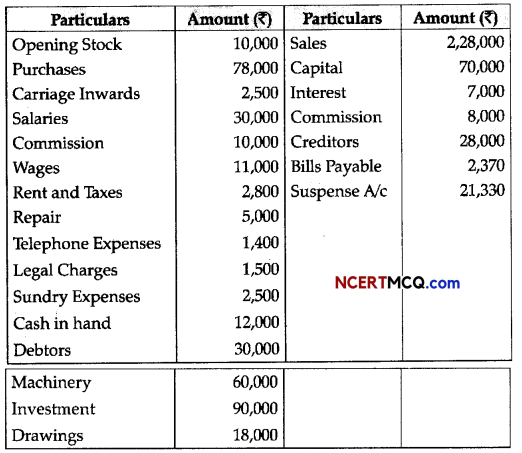
Stock as on March 31st, 2011 ₹ 22,000.
Answer:
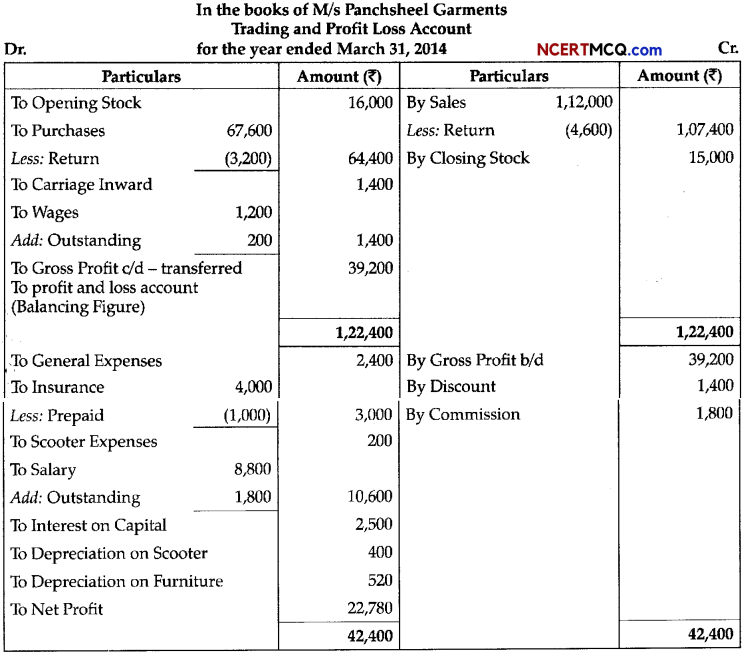
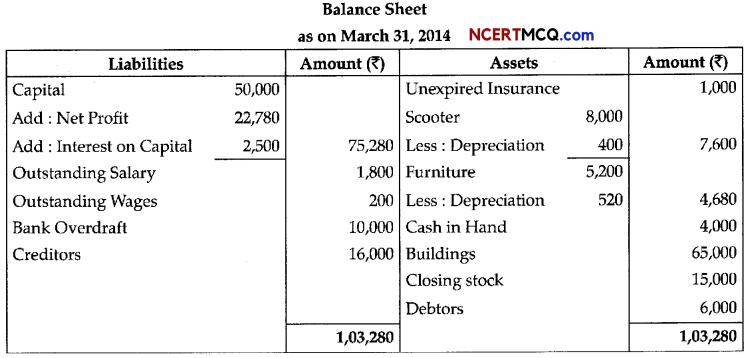
Working Note:
- Calculation of Interest on capital: 5% of ₹ 50,000 = ₹ 2,500
- Calculation of Depreciation on Scooter: 5% of ₹ 8,000 = ₹ 400
- Calculation of Depreciation on Furniture: 10% of ₹ 5,200 = ₹ 520
OR
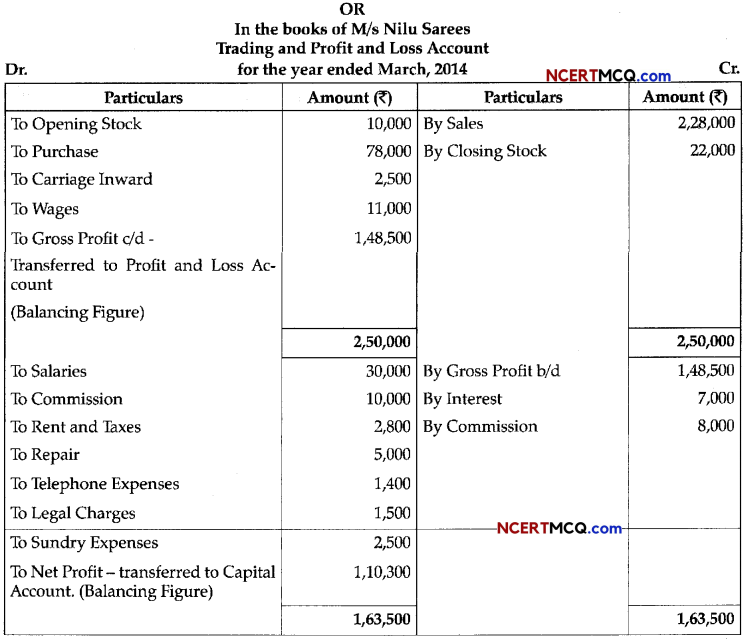
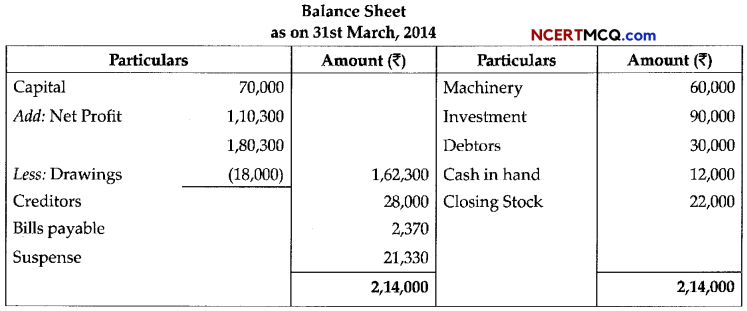
Note: The balance of suspense account has been given in the credit side of the trial balance, hence is to be transferred to the liabilities side of the balance sheet.
![]()
Question 12.
Jagdish the new accounting manager wants to install the Accounting software for accounting to help his company in making the accounts faster. His C.E.O wants him to give a presentation in the board meeting. State the advantages of using Accounting Information System, that Jagdish can use in his presentation. [5]
Answer:
The advantages of using computerized accounting software are:
1. Automation: Since all the calculations are handled by the software, computerized accounting eliminates many of the mundane and time-consuming processes associated with manual accounting. For example, once issued, invoices are processed automatically making accounting less time-consuming.
2. Accuracy: This accounting system is designed to be accurate to the minutest detail. Once the data is entered into the system, all the calculations, including additions and subtractions, are done automatically by software.
3. Data Access: Using accounting software, it becomes much easier for different individuals to access accounting data outside of the office, securely. This is particularly true if an online accounting solution is being used.
4. Reliability: Because the calculations are so accurate, the financial statements prepared by computers are highly reliable.
5. Scalable: When a company grows, the amount of accounting necessary not only increases but becomes more complex. With computerized accounting, everything is kept straight forward. because shifting through data using software is easier than shifting through a bunch of papers.
6. Speed: Using accounting software, the entire process of preparing accounts becomes faster. Further more, statements and reports can be generated instantly at the dick of a button. Managers do not have to wait for hours, even days, to lay their hands on an important report.
7. Security: The latest data can be saved and stored in off-site locations, so it is safe from natural and man-made disasters like earthquakes, fires, floods and terrorist attacks. In case of a disaster, the system can be quickly restored on other computers. This level of precaution is taken by Clever Accounting.
8. Cost-effective: Since using computerized accounting is more efficient than paper-based accounting, work will be done faster and time will be saved. When one considers, Clever Accounting, one of the latest online accounting solutions, which starts at a low monthly subscription, then computerized accounting really becomes a no-brainer.
9. Visuals: Viewing your accounts using a computer allows you to take advantage of the option to view your data in different formats. You can view data in tables and using different types of charts.